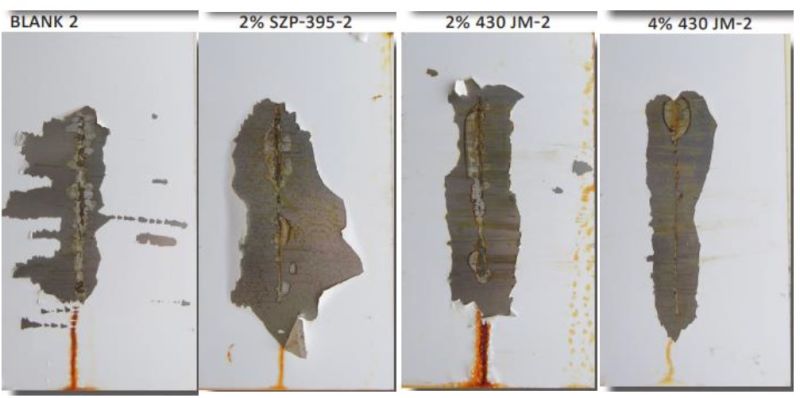Knowde Enhanced TDS
Identification & Functionality
- Chemical Family
- Chemical Name
- Pigment Type
- CASE Ingredients Functions
- Technologies
- Product Families
- Chemical Description
Calcium Phosphate Based Inhibitor
- Mechanism
- Cathodic passivation and ion exchange/scavenging
Features & Benefits
- Labeling Claims
- CASE Ingredients Features
- Benefits
The jet-milled feature of HALOX® 430 JM offers significant advantages :
- Thin film applications (<10 microns)
- Easier to disperse
- Cleaner grinds
- Improved efficiency
- The Sustainable Future
- Patented Calcium Phosphate
- Ion Exchange Technology
- JM (jet milled version) for smaller particle size
- Advantages
- The jet-milled feature offers significant advantages for thin film applications (<10 microns). It is easy to disperse and provides cleaner grinds for improved corrosion inhibition efficiency. It is a moderate solubility corrosion inhibitor and hexavalent chromate replacement option for galvanized, Galvalume™, and aluminum alloys.
Applications & Uses
- Applications
- Compatible Polymers & Resins
- Compatible Substrates & Surfaces
- Coating Type
- Applications
- Thin Film Coatings
- WB 2K Epoxies
- SB 2K Epoxies
- Hybrids
- High Solids Epoxies
- Aerospace, Auto Refinish
- Cathodic Inhibitor
- Clear Coats
- Latex Emulsions
- WB 2K Polyurethane
- DTM Finishes
- Polyesters
- Powder Coatings
- Recommended Loading Levels
Application recommended loading levels based on total formula weight.
Coatings System Water-borne Solvent-borne 2K Epoxy 2-6% 8-12% Alkyds & Modified Alkyds 2-6% 6-10% 2K Polyurethane 2-6% 6-10% Acrylic Copolymer 2-5% - Polyester Melamine/TGIC - 6-9%
Properties
- Appearance
- White Powder
- Typical Properties
| Value | Units | Test Method / Conditions | |
| Density | 2.7 | g/ml | — |
| Hegman Grind | min. 6 | — | — |
| Mean Particle Size | 2 | microns | — |
| Moisture Content | 1.1 | % | — |
| Oil Absorption | 50 | lbs/100 lbs | — |
| pH (10% Solution by Weight) | 8 | — | — |
| Solubility in Water | 0.02 | % | — |
Regulatory & Compliance
- Certifications & Compliance
Technical Details & Test Data
- HALOX® 430 JM versus Zinc Containing Cl, SZP 395
Water based Light Industrial PU DTM with 2% CI on TFW
Panel Data
B1000 Gloss Scribe Creep ASTM D
1654ID Cross
Hatch
Adhesion20° 60° 85° Scribe Creep
(mm)
AVG of 2
panelsB1000
% Improvement
vs CTLAVG of 2 panels Blank 3B 37.4 76.2 96.4 10 CTL 2% SZP395 3B 29.5 72.6 95.6 11.75 85% 2% 430 4B 28.2 71.4 96.7 5.5 182% ASTM B117, 144 hours, DFT @50 microns, B1000

Water based Light Industrial PU DTM with 2 4% CI on TFW
Panel Data
CRS Gloss 144 hours ID Cross
Hatch
Adhesion20° 60° 85° Scribe Creep
(mm)
AVG of 2
panels%
Improvement
vs CTLAVG of 2 panels Blank 0B 39 76 95.7 19.75 -- 2% 395 0B 30.3 72.3 97 19 104% 2%
430JM2B 27.9 70.2 96.4 11.5 172% 4%
430JM2B 22 66.7 95.3 9.875 200% ASTM B117, 144 hours, DFT @50 microns, CRS

- Heavy Metal Free versus Zinc
Water based Light Industrial DTM Epoxy, ASTM B117, 4 mils DFT over CRS
CRS 168 Hours Sample Panel # DFT Visual
Scribe
Creep
Rating
ASTM
D 1654Field
Corrosion
ASTM
D
610Field
Blistering
ASTM D
714Scribe Creep
(mm) AVG of
2 panels%
Improvement
vs CTLCW314 1 4.72 8 10 10 2.875 917% 2 4.70 8 10 10 SZP395 1 4.56 8 10 10 3.9375 670% 2 4.55 6 10 10 700 1 4.59 5 10 10 670% 414% 2 4.7 4 10 10 5% loading level

- Factors to Consider while Creating Coatings Solutions
- Combine the inhibitors utilize synergy of multiple mechanisms to achieve desired performance.
- Inorganic/Flash Rust
- Inorganic/Inorganic
- Inorganic/Organic
- Optimize Solubility of the inhibitor. Synergize short term and long term corrosion inhibitors based on their solubility.
- Inhibitor Concentration avoid direct weight to weight replacements. Beneficial to optimize usage level.
- Substrate specific corrosion inhibitor selection can be substrate dependent.
- Combine the inhibitors utilize synergy of multiple mechanisms to achieve desired performance.
Storage & Handling
- Shelf Life
- 36 Months

